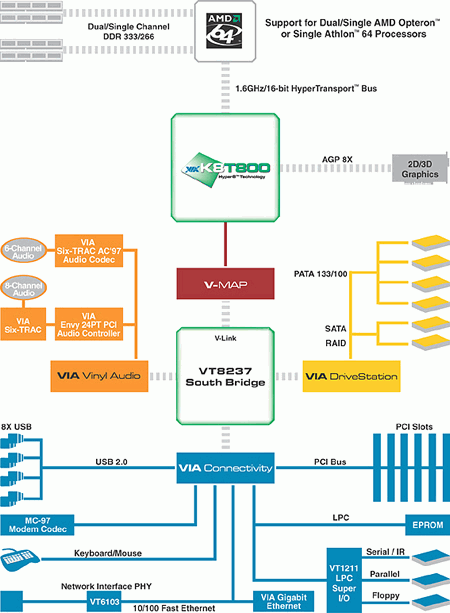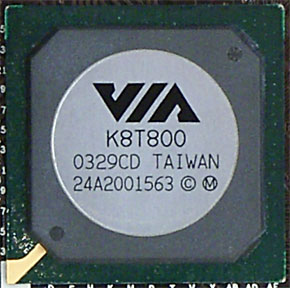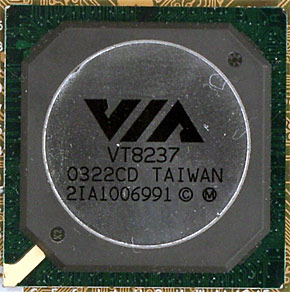 |
||
|
||
| ||
While waiting for the Athlon 64 CPUs to be announced VIA not only released a chipset line for them but also updated it. Other companies are not such fruitful, and today we have actually only two chipsets for the Athlon 64: VIA K8T800 and NVIDIA nForce3 Pro. However, there are no dedicated chipsets for the Athlon 64 as all K8 processors are connected to any chipset via the HyperTransport bus which doesn't care about differences between sockets/CPU families installed on a certain board. But we stress on the Athlon 64 because of the positioning: the first released chipset, AMD8000, is used in no mainboards with AGP slots so far. That is why it's of no interest for over 90% of home users, while the Athlon 64 is developed exactly for such people (though not at its current price). Other solutions for the AMD64 are ALi (ALi 1687) and SiS (SiS755/SiS755FX) though we haven't yet seen boards based on such chipsets. Next year ATI will probably bring out an integrated solution. Nonetheless, two chipsets are enough to compare performance of the system logic meant for the Athlon 64/FX and Opteron. Usually at the expense of technical innovations (original like DASP in the nForce/2, or common like two memory channels) or some other factors chipsets from different companies can have considerably different performance. But what do you expect from two chipsets whose north bridges feature only an AGP controller, especially because video accelerators today do not actually need its maximum throughput. Components connected via a south bridge are usually coincide, and the overall speed hardly differs (we take into account only the desktop usage and ignore the need of PCI-X, several Gigabit network connections and solid RAID arrays). So, what else can be compared? VIA stakes on the HyperTransport controller integrated into the north bridge. VIA K8T800One of the advantages of the chipset is the Hyper8 technology which implies the HyperTransport support between the CPU and chipset that delivers 16bit/800 MHz in both directions.  The nForce3 based boards support only 8 bits/600 MHz one way and 16 bits/600 MHz the other. But it doesn't matter much since the only serious data consumer in any AMD64 based chipset (data are taken from memory via HyperTransport controller integrated into the chipset) is an AGP video controller which has a very light load today - and it may become important only for future workstations and servers with PCI-X and PCI Express buses. Since the BIOS of several K8T800 based boards allows adjusting bit capacity and clock speed of the HT bus we quickly tested the boards in the Return to Castle Wolfenstein and SPECviewperf and revealed no difference in these modes. By the way, SiS offers the HyperTransport clocked at 1 GHz. :) 
 The real (not only boasted) specs are the following (south bridge functionality is given for the VT8237, though it's not forbidden to use any other older bridge from VIA):
One more critical difference is the number of chips forming a chipset. NVIDIA combines all logic in a single die while the other companies offer traditional two-chip solutions. The former solution is less flexible (the more frequently updatable south bridge can't be separately replaced) but it's simpler to design boards on it. End users mustn't care about it. PerformanceTestbed:
Software:OS and drivers:
Test applications:
Here are brief specs of the boards tested today:
Test resultsWe do not take into account the marketing tricks with the HT bus throughput (which anyway remains the same in boards on the same chipset). The only different parameters are memory timings. Most of the boards have no limitations there, and the TwinMOS modules allow starting the test system at 2-2-2-5. However, the Gigabyte board works only at 2.5-2-2-5, and the Soltek K8AV2-RL starts at 2.5-3-3-8. Let's have a look at the difference in the low-level tests.
Both boards with the different timings have greater read access latency, but they score pretty high results in reading/writing: the Soltek loses just a couple of percent, and the Gigabyte K8VNXP makes up for poor latency with the highest write speed. The other boards have almost identical results. The MPEG4 encoding reveals the difference in the memory speed, but still, it's rather a processor test which doesn't depend much on latency. The scores are absolutely equal. The archivers are to prove the low-level benchmark scores as they are most critical to the memory subsystem performance. The Gigabyte K8VNXP keeps to the three boards with identical parameters, while the Soltek K8AV2-RL falls behind the pack by 17-19%. Games are a very important test for future owners of the Athlon 64 based systems. TheSoltek falls behind the leaders by 2-3% while the Gigabyte demonstrates yields less than a percent, i.e. it can be considered just a metering error. The formal leaders are Albatron K8X800 Pro II and MSI K8T Neo-FIS2R. Integrated audio qualityIntegrated audio quality was estimated at 16 bits, 44 kHz with the
RightMark Audio Analyzer 5.1
and Terratec DMX 6fire audio card:
The boards that integrate the VIA VT1616 codec - Soltek K8AV2-RL and Albatron K8X800 Pro II - look best of all; also note that the Albatron features not only the audio codec but also a normal audio controller. Remember that we directly compare these models as they are based on the same chipset and therefore they will be considered direct competitors. The chipset itself doesn't influence audio quality (codec, its output signal level, amplifier on codec's output, feed-through electrochemical capacitors, PCB design may affect it), that is why you can use the data obtained to make a cross comparison of models on other chipsets. ConclusionFirst of all I should say that it actually makes no sense to compare boards based on the chipsets for AMD64 a traditional way. There can be some slight difference between different chipsets in some critical modes, but boards based on the same chipset do look like twins. I do not doubt that the updated BIOS will provide normal timings for the Soltek K8AV2-RL and it will catch up with the others. But even with the current awful timings and poor scores in the low-level tests the Soltek look pretty good in games, video encoding and obviously in many other typical home applications. Secondly, as performance isn't a determining factor anymore, there are
some other vital factors that influence the demand: features, accessories,
oveclockability, stability etc. and certainly price! The companies have
different approaches to conquering the market: most of them offer only
one or two expensive models (according to positioning of the Athlon 64),
others deliver performance of this CPU at a relatively low price without
offering extra bonuses. Do read descriptions of the boards as they can
bring you much more information than the diagrams. At the same time we
extend our benchmarks with integrated audio quality tests. We will be pleased
to know your opinion about current solutions and your suggestions.
Write a comment below. No registration needed!
|
Platform · Video · Multimedia · Mobile · Other || About us & Privacy policy · Twitter · Facebook Copyright © Byrds Research & Publishing, Ltd., 1997–2011. All rights reserved. | ||||||||||||||||||||||||||||||||||||||||||||||||||||||||||||||||||||||||||||||||||||||||||||||||||||||||||||||||||||||||||||||||||||||||||||||||||||||||||||||||||||||||||||||||||||||||||||||